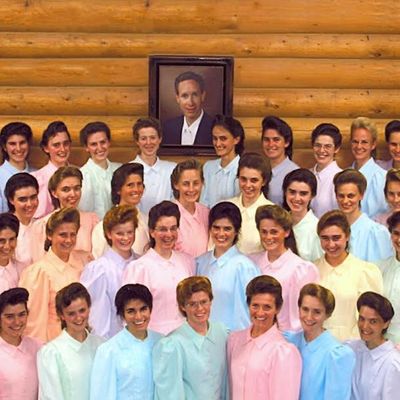
ItÔÇÖs been a big year for documentaries about cults, cranks, and crazies, with the Scientology expos├® Going Clear┬áa few months ago and white-supremacist-takeover thriller┬áWelcome to Leith┬ájust last week. And now, Amy BergÔÇÖs new film looks at the rise and fall of cult leader Warren Jeffs, the head of the Fundamentalist Church of Jesus Christ of Latter-Day Saints (FLDS), a splinter group that felt the Mormon ChurchÔÇÖs official renunciation of polygamy back in 1890 constituted a betrayal of its principles. Jeffs, as some may recall, was all over national headlines in 2006 and 2007 when the FBI placed him on its 10 Most Wanted List and then arrested him, revealing to the world his twisted ideology and his army of brainwashed wives (as many as 70 or so). Much of the debate at the time was about what to do with JeffsÔÇÖs dozens upon dozens of spouses and children after his arrest. Do you split up these families, or do you let them go about living their highly sheltered lives in their church ÔÇö even though much of that church was built by a charlatan and a criminal?
Jeffs was more than a false prophet and a tyrant; he was also a rapist who sexually abused young girls and boys at his church and at the school he founded and ran. Those revelations come from one of his victims ÔÇô a nephew whose father, WarrenÔÇÖs brother Lyle, now nominally runs the church. (Apparently, Warren Jeffs still has real control over the church, even though heÔÇÖs serving a life sentence.) This isnÔÇÖt the first film that Berg has made to deal with the nexus of sexual abuse and political/professional/religious power: Her 2006 film┬áDeliver Us from Evil looked at rape in the Catholic Church, and more recently she made┬áAn Open Secret, which tackled the molestation of child actors in Hollywood. But that aspect of JeffsÔÇÖs world isnÔÇÖt the primary focus here. Rather, ProphetÔÇÖs Prey┬áinterweaves the rise of the FLDS and of Jeffs himself, as well as the years-long investigation into the church conducted by journalist Jon Krakauer and private investigator Sam Brower. (The film is based partly on BrowerÔÇÖs own book┬áProphetÔÇÖs Prey, published in 2011.)
Berg also explores the mind-set that allows people to be controlled by someone like this. What she finds, of course, is a combination of ignorance, eerie charisma, and fear. Jeffs preached about the end times, and he made sure that his congregants knew that if they strayed in the slightest, they would be damned. Offenses included interacting with people not in the FLDS, or looking at outside media. Schools didnÔÇÖt teach U.S. history; they taught the history of the church. As with Scientology, there was a sadist edge to it all, too: ÔÇ£He hated people to be happy,ÔÇØ weÔÇÖre told. ÔÇ£The more afraid, the more threatened ÔǪ the more they were bound to him.ÔÇØ So, how in hell was this man, who was told from a very young age that he was a prophet, able to have this kind of hold over people? True, he inherited an already-ignorant flock. But thereÔÇÖs something more here, too. Listen to JeffsÔÇÖs voice, in the recorded sermons included in the film: His is the gentle monotone of the hypnotist. ThereÔÇÖs no real warmth or compassion in his voice, but rather a lulling, cool authority. ItÔÇÖs like something out of a thriller.┬á
Indeed, at times you wonder if┬áProphetÔÇÖs Prey┬ámight have worked better┬áas┬áa thriller. Brower discusses the depth of the corruption in Short Creek, the small Utah town where the FLDS was located, with local authorities and businesses and everyone else seemingly controlled by the church. ItÔÇÖs like one of those rural┬ánoirs┬áwhere the protagonist gets trapped in some sleaze-bag town where everyone is against him, and canÔÇÖt escape. Meanwhile, Berg often cuts to shots of FLDS members, decked out in their 19th┬ácentury pioneer garb, walking and frolicking outside while hymns play on the soundtrack: Americana gone haywire, like something out of a David Lynch movie.
At times, I found myself wishing Berg focused more on Brower and KrakauerÔÇÖs investigations and given the film a more present-tense narrative. This is a fascinating movie, but thereÔÇÖs a lot to cover here, and one can occasionally feel lost amid all the strands.┬áGoing Clear┬áhad a similar challenge ÔÇö how to juggle all these horrifying details ÔÇö and opted for sheer data overload, giving us so much information about the cult that we were too busy being flabbergasted to worry about form or structure.┬áProphetÔÇÖs Prey┬ámight not be as shocking. But at its best, this is an absorbing look at how people fall under the control of sick, sadistic hucksters.


